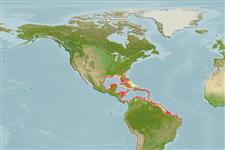Common names from other countries
Environment: milieu / climate zone / depth range / distribution range
Écologie
marin récifal; profondeur 3 - 50 m (Ref. 9626). Subtropical; 34°N - 12°S, 99°W - 32°W
Western Atlantic: Bermuda, southeastern Florida (USA), and the Bahamas to Brazil.
Length at first maturity / Taille / Poids / Âge
Maturity: Lm 19.0 range ? - ? cm
Max length : 33.0 cm TL mâle / non sexé; (Ref. 7251); common length : 25.0 cm TL mâle / non sexé; (Ref. 3798); poids max. publié: 550.00 g (Ref. 5217)
Épines dorsales (Total) : 12; Rayons mous dorsaux (Total) : 15 - 17; Rayons mous anaux: 8. Broad black area above line from dorsal fin origin to tip of lower caudal fin lobe, including upper part of caudal peduncle and both lobes of tail. Striking colored species, with a silvery body, black back and tail (Ref. 26938). With narrow yellow stripes, the broadest mid-lateral (Ref. 13442).
Inhabits clear inshore and offshore reefs (Ref. 9710) and adjacent grass beds, often in schools (Ref. 3798). Feeds on crustaceans (Ref. 3798). Marketed fresh (Ref. 3798).
Oviparous, distinct pairing during breeding (Ref. 205).
Robins, C.R. and G.C. Ray, 1986. A field guide to Atlantic coast fishes of North America. Houghton Mifflin Company, Boston, U.S.A. 354 p. (Ref. 7251)
Statut dans la liste rouge de l'IUCN (Ref. 130435)
Can't connect to MySQL database (fbapp). Errorcode: Too many connections
